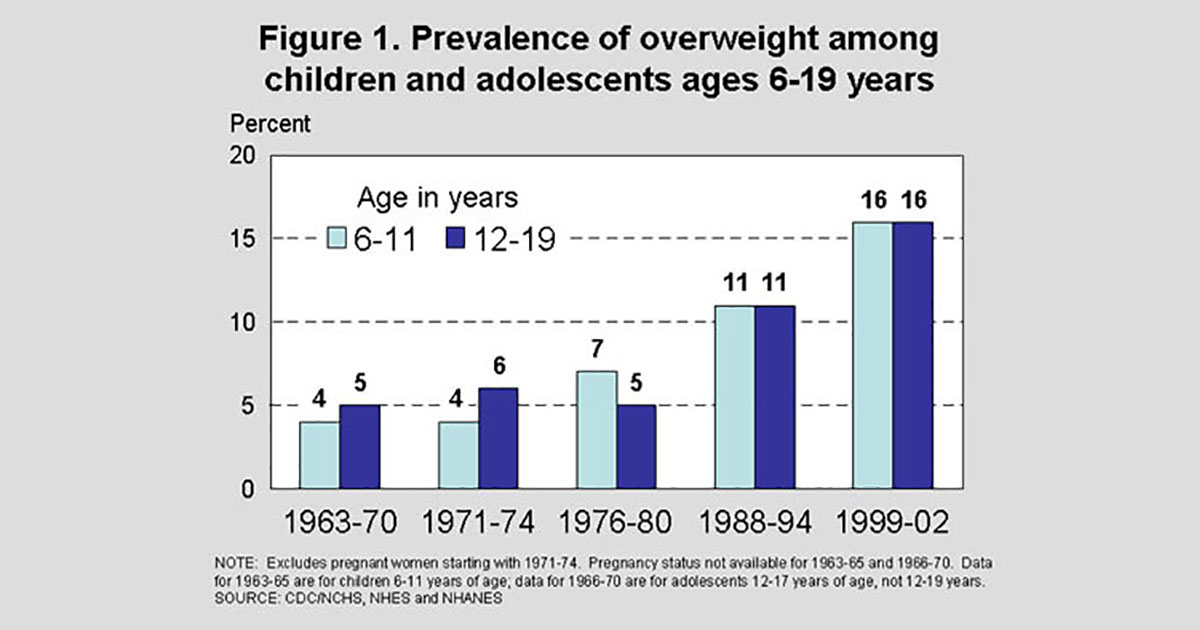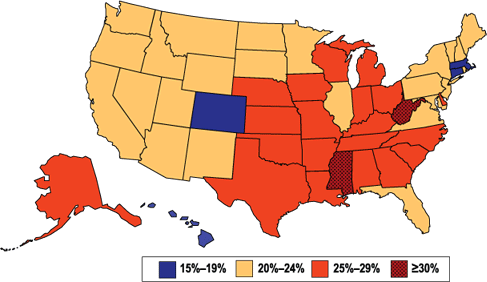
We've all heard the statistics from the Centers for Disease Control and Prevention (CDC). Over nine million children between the ages of 6 and 19 are overweight or downright obese. That's 16 percent of children in those age groups. If you're African-American or Mexican-American, it's even worse. Twenty-one and 23 percent of adolescents from those groups, respectively, are overweight or obese, and it's almost as bad for kids under age 12 from those groups.
Worse, the percent of kids struggling with overweight has risen rapidly and is still rising. As you can see in the chart on the right, between 1994 and 2002, the percent of overweight or obese children rose 45 percent... and it's still going up.
Those who think the Fat Flood is just due to poor self-control and bad eating habits might be in for a rude awakening. As we at Practical Homeschooling investigated the causes of childhood obesity, we found some disturbing information. The culprits range from changes in the way food is grown and processed, to additives, to the increase in dietary soy, and more. If you buy your food from a supermarket or grocery, your children are at risk from ticking nutritional time bombs.
Gone are the days when calorie counting and a few more exercises could "fat-proof" your child. You need to know much more than the mainstream media are telling you.
No Wackiness Here!
Before we start, let us reassure you that you won't be reading any "crank" diet prescriptions or denominational food suggestions in Practical Homeschooling. We aren't beating the drums for any particular nutritional agenda, and we certainly aren't the Diet Police. Our goal is in this column is to alert you to all the possible causes for childhood obesity that we know about, so you can take appropriate preventative measures.
Future columns will address what to do if your children are already overweight, or are unaccountably "plumping up."
It's Not Your Fault
The first point we want to make, very strongly, is that if your children are getting fat, it likely isn't your fault.
We personally don't know any homeschool parents who encourage their children to dine on Twinkies, never offer them fruits or vegetables, and leash them to the living-room couch or videogame console.
Often those who are blessed with naturally high metabolisms or who have, without planning it, managed to avoid the major triggers of obesity, tend to "lord it" a bit over those not so blessed. People who would never dream of mocking a blind person or someone in a wheelchair often feel free to judge those trapped in an oversized body.
Think it through. In the eight years from 1994 to 2002, childhood obesity rose 45 percent. Is it likely that 45 percent more families suddenly decided to live on junk food during that period? If junk food and laziness is the cause, what could have made millions of families suddenly adopt that lifestyle... in the midst of the exercise craze, no less?
The childhood obesity pandemic can't be all about "fat genes" versus "lean genes," either, unless you believe that six years prior to 1994, suddenly only fat people decided to procreate. In fact, overweight adults have less fertility than other adults. So that explanation doesn't work, either.
We'd also like to know why overweight varies so much from state to state and region to region. In places where you'd expect it to be higher-e.g., states that border on Mexico, since Mexican-Americans have a much higher overall rate of obesity-it might be lower than a Midwest, Southern, or Northern state. For no apparent reason, Colorado, Massachusetts, and Connecticut have the lowest overall obesity rate.
Colorado, for example, is surrounded by states whose obesity rate is 5 to 15 percent higher. If Coloradans are slimmer because Colorado is a mountain state, then why is West Virginia, another mountainous state, one of the fattest states in the country? Why are people in Mississippi fatter than folks across the Mississippi River in Louisiana?
Look at the map in the middle of this page, and you'll see that the prevalence of obesity in the USA follows no obvious rhyme or reason. Neither climate, nor altitude, nor distance from the sea, nor distance from neighboring countries, are adequate explanations for why some states are more overweight than others.
Can't Get No Satisfaction
"Thou shalt eat, but not be satisfied" (Micah 6:14). This is a judgment God pronounced on His people when they decided to prefer wealth and image to truth, justice, and Him.
Seeing an epidemic of people in our modern world who literally eat and are not satisfied... who are still hungry after eating enough calories... whose appetite leads them to put on weight... I am wondering if this passage might have a literal application here and now.
High Fructose Corn Syrup
A Washington Post article published March 11, 2003, was one of the first to point out the connection between what's happening to American food and how fat we are getting. "Increasingly, it's not just the growing consumption of foods with added sugars that concerns some nutrition experts," the article pointed out. "What has also changed during the past four decades, the USDA figures show, is the type of sweeteners consumed-a trend that some studies suggest may help to undermine appetite control and possibly play a role in weight gain." The Post noted that, "According to the latest figures from the U.S. Department of Agriculture (USDA), consumption of various sweeteners, often in calorie-dense foods and drinks, has risen in the United States from an estimated 113 pounds per person in 1966 to 147 pounds in 2001." Manufacturers made the switch because fructose is cheaper than sugar and delivers even better sweetness. But unlike sugar, which increases the production of the appetite-suppressing hormone leptin, you can gobble huge amounts of fructose without ever feeling full.
Start reading supermarket labels and you'll see-corn syrup is everywhere.
A statistically verifiable connection has been made between how much high fructose corn syrup sweetened soda pop kids ingest and how fat they become. A 2001 Boston Children's Hospital study showed the researchers could predict how much weight kids would gain over a time period by how many soft drinks they had each day. "The calories from just one extra soft drink a day gave a child a 60 percent greater chance of become obese," according to the book Fat Land.
Artificial Sweeteners
So the solution is to switch to diet soda, right?
Not so fast. According to an October, 2004, article in one of my favorite health newsletters, Alternatives:
Researchers at Purdue University have found that... artificial sweeteners appear to disrupt your body's natural ability to regulate food intake and body weight.
Normally "our bodies have the innate ability to match caloric intake with caloric need." When we eat sweet foods, dense foods, or gluey foods, our bodies pick up on the fact they are high in calories, and signal us to stop eating before we consume too much. But when artificial sweeteners come into the picture for a while, "the body can no longer rely on this instinct." Sweet no longer automatically means "high calorie," so when we eat actual sugary foods, our bodies can't tell when we should stop.
Again, studies have shown that each serving of diet soda you drink per day increases your chances of obesity. This would also seem to apply to trying to cook with sugar substitutes.
The Soy Ploy
If you Google the two words "soy obesity," up come a raft of pages about how soy components are supposed to help ward off adult obesity. However, we are much more convinced by the research, books, and articles that point out a link between the use of infant soy formula and later obesity. For a starting point for more on this topic, go to www.westonaprice.org/soy/soy-industry-on-attack.html.
The Hormone Zone
Could feeding cows, pigs, chickens, and sheep growth hormones affect our meat, milk, and eggs? After two of our daughters gained 100 pounds each shortly after puberty, we switched to hormone-free products and the next two stayed slim before and after puberty.
The truth is that our soils are progressively poorer, the number of additives in our food (to which your children may be allergic) is alarming, fat and sugar substitutes are everywhere in the food you buy at the supermarket, and foods ranging from baby formula to chicken wings may be disrupting your children's hormones. Next issue we'll talk about this-and what you can do about it.
Percent of Obese (BMI > 30) Adults in USA as of 2006

The data shown in this map was collected through the Centers for Disease Control and Prevention's Behavioral Risk Factor Surveillance System (BRFSS). Each year, state health departments use standard procedures to collect data through a series of monthly telephone interviews with U.S. adults. Prevalence estimates generated for the maps may vary slightly from those generated for the states by the BRFSS as slightly different analytic methods are used.